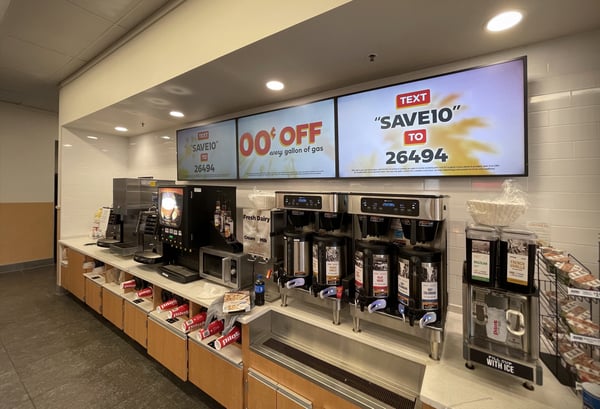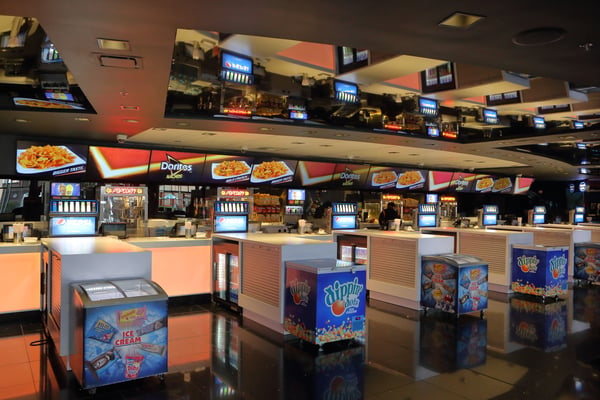Digital Signage Technology Trends to Monitor
In the ever-changing landscape of digital signage, the evolution of technology is steering businesses towards possibilities once thought impossible. As we step into the future, it becomes crucial for organizations to not only adapt to these trends, but also thrive by embracing the technology that is reshaping the way businesses connect with their audiences. Although many digital signage technology trends have come and gone without realizing true mainstream adoption, we believe these five trends will be around for the long run.
Without further ado, let's discuss five critical digital signage technology trends that will continue to shape the digital signage industry in the coming years.

Movement Toward Cloud-Based Signage Management Software
At this juncture, the emergence of cloud-based signage management software is less of a trend and becoming more of a best practice. If your digital signage management software is not hosted on the cloud, you have already fallen behind the pack.
The print-ship-hang model is dead and gone, and localized signage management presents a world of challenges and potential pitfalls.
Cloud-based signage management is so advantageous because it makes it incredibly simple to manage digital signage at scale. Using cloud-based software, a restaurant chain can update its signage at several hundred locations as easily as it would one location. The ease of adjusting creatives provides corporate with the flexibility (if they so choose) to allow individual locations to adjust their signage displays based on any specific trends they are seeing in purchase behavior, or to engage in top-down, location-specific imagery testing. Centralizing the management of your business’s digital signage makes it simple to measure success and evaluate the entirety of your strategy without any information gaps or misalignment.
Cloud-based signage can also grow alongside your business, which is absolutely essential for organizations that plan on increasing in scale. Your business can only get by with localized signage management for so long, and the larger your business gets, the more risk of brand discrepancies and discontinuities you incur. A cloud-based signage management solution makes it simple to ensure a consistent look and feel across all of your locations.
Additionally, the ability to templatize creatives and dynamically populate information vastly improves operational efficiency by enabling brands to leverage “plug-and-play” imagery that can fill itself in based on pre-set factors, such as time of day. This means that your boards will automatically switch from breakfast to lunch at a pre-set time without anyone having to lift a finger, creating a smooth experience both for you and your customers.
Lastly, the cloud-based software is far more secure than its on-premise counterparts. Organizations leveraging cloud-based signage management software can assign permission levels, as well as bolster security with two-factor authentication. There is also no risk of your physical servers being destroyed, as cloud-based solutions provide an additional layer of protection in case of disaster.
If your business is not taking advantage of cloud-based digital signage management software at the moment, we highly recommend you make the change.

Artificial Intelligence and Data Analytics
No discussion about emerging trends in the digital signage realm would be complete without mentioning artificial intelligence. Although many organizations are currently using AI to identify process gaps (such as monitoring screens and verifying whether the correct content is playing), the future is going to look considerably different. Expect to see organizations begin to deploy artificial intelligence to create dynamic playlists, and even optimize displays in real-time based on who is viewing signage. In the future, AI is likely to develop a more nuanced understanding of the contextual factors that influence the decision-making of customers. Whether that is time of day, weather, or in some cases where the data may be available, prior purchase behavior.
The goal of every digital signage program should be to drive as much revenue as possible by personalizing signage displays. Ten or so years from now, don’t be surprised if artificial intelligence is tweaking signage displays in real-time to reflect the preferences of individual viewers, while also taking into account external variables that may impact their purchase behavior at a particular point in time.
Outside of AI, expect to see the way organizations leverage their data regarding their signage continue to progress as well. As integration capabilities become more complex (more on that later), organizations are starting to draw more concrete conclusions on which versions of their signage displays drive the most revenue by tying their signage software to their point-of-sale system. More and more businesses want visibility into proof-of-play data that tells them that their creatives were seen a certain amount of times, and provides the ability to identify trends between their view data back and their revenue numbers.
Laser-focus on data and analytics not only informs more strategic testing and allows businesses to put their most successful creatives in the spotlight, it positively impacts revenue.
We expect businesses to continue to leverage their data to draw tangible conclusions on the success of their signage initiatives, and for AI to become a massive part of this puzzle in the coming years.

Interactive Touchscreens
Interactive touchscreens are not new to the world of digital signage technology, but it certainly seems that they are starting to take root as a permanent fixture in the industry. We see touchscreens being used very frequently in the QSR industry, where self-service kiosks are helping drive more sales while also enabling organizations to decrease their labor costs. YUM Brands CEO David Gibbs recently noted that average kiosk sales are 10% higher than front counter sales in locations in which they have been tested. We would not be surprised to see more cold hard data come out in the next few years that further illustrates the effectiveness of self-service kiosks in the restaurant business.
However, this isn’t the only industry where interactive touchscreens are skyrocketing in popularity. Retail stores, schools, corporate offices, and public spaces like airports are all making use of interactive screens, whether that is for wayfinding, internal employee communications, or any number of additional use cases. The ability to interact with signage isn’t only “cool”, it actually makes it easier to find where you need to go or communicate with your team.
However, this isn’t the only industry where interactive touchscreens are skyrocketing in popularity. Retail stores, schools, corporate offices, and public spaces like airports are all making use of interactive screens, whether that is for wayfinding, internal employee communications, or any number of additional use cases. The ability to interact with signage isn’t only “cool”, it actually makes it easier to find where you need to go or communicate with your team.
Additionally, expect the level of interactivity used in signage to continue to evolve beyond touchscreens. One of our clients is currently experimenting with an “interactive scavenger hunt” that leverages augmented reality using an app on the viewer's phone to enable the viewer to interact with their signage in a more engaging manner. Similar initiatives have particular potential in venues such as theme parks and movie theaters, where providing larger-than-life entertainment is a major aspect of driving an unforgettable customer experience and ultimately more revenue.
Expect interactive touchscreens to stick around, not only due to their ability to drive revenue in the immediate future, but to also lower operating costs and drive an improved experience for customers.
System on a Chip (SoC) Screens
What if your signage screens could have built-in computers and require no additional hardware to operate? System on a chip (SoC) screens first hit the market about ten years ago and can provide quite a few unique advantages to users. Although these screens tend to be more expensive up-front, they often cut down on the cost of deployment in the long run because they are specifically designed to be efficient, and do not require external players or computers to display your creatives. Using SoC screens means fewer moving parts and generally, a smoother deployment process. Fewer moving parts also means fewer potential failure points, which makes it easier to identify the solution in the event of a malfunction. SoC users are also able to pull more complex data on their screens and understand how long they’ve been on, how hot their CPU is running, and more.
Although SoC solutions have some limitations, namely synchronization and what kinds of visuals can be presented, these limitations are rapidly disappearing.
One challenge that comes with utilizing SoC screens is that the use of these screens essentially locks you into a partnership with a particular provider (LG, Samsung, Phillips, etc). These providers often update their screen bezel size or colors, meaning that if one of your screens stops working, you’d need to replace all of your screens to have a uniform set. This is something to keep in mind when you are selecting your screens, as you do not want to have to replace all of your screens in the event that one breaks.
Additionally, since the components of SoC screens are so robustly integrated, if one tiny component of a screen breaks, it may break the entire screen. Replacing individual parts can be very challenging or impossible, requiring the user to replace the entire screen in certain cases.
Despite their potential shortcomings, SoC screens are likely here to stay in the signage world due to their ability to simplify the roll-out of signage initiatives and create long-term cost savings.

Deeper Integrations with Back-Office and Third-Party Data Sources
As organizations attempt to get more out of their digital signage, the depth and breadth of the integrations they are seeking are increasing. Although integration with point-of-sale systems is commonplace, we are seeing more and more businesses looking for more unique integrations that can fuel an improved customer experience. Just a few weeks ago we spoke with a fitness brand looking to integrate its signage software with its scheduling program to display appointment calendars and class schedules on its screens. Undoubtedly, this is a worthwhile integration and could be an excellent use of their screens.
Another common integration need we see frequently is in the quick-service restaurant industry. Robust integration with inventory management software provides businesses with the opportunity to remove menu items that are out of stock from their screens, saving customers the confusion that can come with ordering an item that is unavailable.
In the future, tools like artificial intelligence may even be able to leverage this integration to create limited-time offer campaigns based on inventory that is soon to expire. This will help businesses reduce waste while reaping the benefit of increased sales. Remember, the future of digital signage will be deeply tied to artificial intelligence and its ability to evaluate and make use of data from all of your systems.
As the capabilities of digital signage technology continue to become more robust, expect to see a push toward useful integrations that are a bit more outside the box, but equally impactful in terms of driving results.
Conclusion
As your business navigates the ever-changing digital signage landscape, it is critical not to just be aware of trends, but to act on them. It can be very easy to fall behind if your business does not remain on the pulse of the latest digital signage technology trends. If a particular trend makes sense for your business, do not be shy to experiment with the latest and greatest technology. Even if, for example, your 3D signage initiative is a flop, you can rest assured it isn't a hidden gem that can help take your business to the next level. Keep in mind that knowing what does not work can be equally as valuable as knowing what does work.
Although not every technology trend in the digital signage world sticks around for the long haul, we expect the technology we discussed in this piece to ultimately change the complexion of how digital signage provides value to businesses and their customers alike.
If your business is looking to take its digital signage to the next level, give us a call. DEEL Media has worked with some of the world’s largest brands to deliver white-glove digital signage solutions. From video walls, to custom creatives, to revenue-driving menu boards, our team of digital signage technology experts have an intimate understanding of what makes a successful digital signage program. If you are interested in working with us on your next digital signage project, schedule a free consultation or give us a call at 770-619-1225.
Meet The Author
Jeremy Dost
Author
Innovative technologist with over 25 years of hands-on development and leadership experience. I use my extensive knowledge of video processing and streaming, web and mobile applications, API architecture and IoT to further DEEL Media's proprietary digital signage platform, Carbon.
What is Digital Signage, And How is it Different From Regular Signage?
What is Digital Signage, And How is it Different From Regular Signage?
In technical terms, digital signage refers to the use of digital displays or screens to present information, advertisements, or other forms of content. It involves the use of technologies such as LCD, LED, or projection screens to display multimedia content, including images, videos, text, and interactive elements. Simply put, it is a more engaging way to display messages than traditional signage.
You can find digital signage everywhere, from retail stores, to airports, to hotels, to restaurants, to schools. It serves as a dynamic and flexible communication tool that allows businesses and organizations to deliver targeted messages to their audience.
The first key difference between digital signage and run-of-the-mill signage is the ability to display crystal-clear, dynamic content. This can completely transform the experience of a shopper, visitor, or whoever is viewing your signage. The bright display is hard to ignore, especially when it is in video format. Digital signage is simply more effective at attracting attention than conventional signage. Think about your personal experiences. Which menu board do you think commands more attention, a chalkboard with the day’s specials, or a visual display with bright colors and real, moving imagery showcasing one of the day’s specials?
Beyond higher engagement, another major difference between digital signage and traditional signage is the flexibility provided by digital signage. Rather than taking down your signage every time you want to communicate a new message or make an edit, digital signage enables you to store all of your content in one centralized location, and make changes to display with the push of a button. This makes life considerably easier for any organization that runs promotions or is frequently making tweaks to its offerings.
How Does Digital Signage Make an Impact?
How Does Digital Signage Make an Impact?
More Sales: Perhaps the most alluring impact of digital signage is the tangible impact in sales organizations experience after making the switch. This makes perfect sense logically. Again, consider your own personal experience.
Imagine yourself at a movie theater. Are you more likely to buy popcorn upon seeing a generic sign that says “snacks” or after seeing some high-resolution footage of kernels popping, butter being poured, and popcorn being eaten (we are making ourselves hungry)! The answer is pretty clear.
This does not only apply to the world of food. Retail stores, and even convenience stores and gas stations tend to see considerable upticks in sales when they are able to better visually communicate their products, and showcase their promotions and sales offers in an engaging, compelling manner.
Digital signage displays vibrant and dynamic visual content that attracts attention and engages customers. Compared to traditional static signage, digital displays have a higher chance of capturing people's interest. Eye-catching videos, animations, and interactive elements create a memorable and immersive experience, drawing more customers into stores or promotions.
Speaking of promotions, digital signage makes it easier for businesses to promote certain offers in a strategic manner and capitalize on customer interest at a particular time of day or other external factors. This leads to more downstream sales and revenue.
Lastly, let’s consider the impact of digital signage on your brand in general. By displaying engaging, helpful content, such as product demonstrations, customer testimonials, or usage tips, businesses can educate customers and guide them toward making informed purchase decisions. Additionally, digital signage enables businesses to enhance their brand perception by showcasing their values, expertise, or unique selling points. These factors positively influence customer perception, trust, and loyalty, leading to increased sales and repeat business.
Improved Customer Experience: The impact that digital signage has on customer experience is monumental. There are three key ways digital signage improves the customer experience that we’d like to focus on:
More Engaging Visual Content: First and foremost, digital signage allows businesses to display captivating and dynamic visual content, such as videos, images, animations and motion graphics, and interactive elements. This form of visual stimulation captures customers' attention and engages them with the brand or product being promoted in a manner that is far more effective than traditional signage. By presenting visually appealing and relevant content, digital signage creates a more immersive and memorable experience for customers, increasing their overall satisfaction.
Real-Time Information and Personalization: When leveraging digital signage, your business has the opportunity to deliver real-time information and updates to customers. Whether it's displaying current promotions, product features, or event schedules, digital signage ensures that customers are informed and up-to-date, and are being pointed in the direction you want. Additionally, with the integration of data analytics and customer profiling, businesses can personalize content based on customer preferences and demographics. This personalization enhances the relevance of the displayed information, making it more meaningful and impactful for customers.
Improved Wayfinding and Navigation: In many industries such as retail, movie theaters, and theme parks, digital signage can greatly enhance the customer experience by assisting with wayfinding and navigation. In large or complex environments such as shopping malls, or theme parks, digital signage can provide clear and interactive directions to specific locations, helping customers find their desired destinations easily. By reducing confusion and saving customers' time, digital signage improves the overall convenience and satisfaction of their experience within a particular space.
Simplified Operations: When deploying digital signage, your business reaps the benefits of being able to centrally manage and update content across multiple locations or displays. Whether you have one location or 500, you can easily create, schedule, and distribute all of your signage content from a single centralized platform. This eliminates the need for manual content updates on individual displays, saving time and effort for business operators. It also ensures consistency in messaging and branding across different locations, streamlining the content management process, and ensuring compliance with brand standards.
Digital signage also enables remote management and monitoring of displays, eliminating the need for on-site adjustments or maintenance. Through network connectivity, businesses can remotely control and update content, adjust display settings, and troubleshoot issues. This capability simplifies operations by reducing the need for physical intervention, allowing businesses to efficiently manage and maintain displays from a central location. This saves time and resources while ensuring that the signage is functioning optimally.
Lastly, digital signage enables businesses to predefine schedules for content playback, ensuring that the right content is displayed at the right time. This eliminates the need for manual content changes or monitoring. Businesses can also target content based on factors such as location, demographics, or time of day, tailoring the messaging to specific audiences. This targeted approach simplifies operations by delivering relevant content automatically, without requiring constant manual adjustments.
What Does a Great Digital Signage Solution Look Like?
- Scalability and Reliability: Perhaps the most important aspect of a great digital signage solution is the ability to support your current and future needs. Consider your provider’s ability to scale the digital signage network as your business grows. You don’t want to decide on one solution, only for it to not fit your needs in a few years. Look for a provider with a robust infrastructure that ensures reliable uptime and performance, minimizing disruptions and downtime. There is nothing more important than quality, and you must be confident in your provider’s commitment to excellence. After all, what is digital signage worth if it's not operating properly?
- Customer Support and Service: An oft-overlooked but incredibly important aspect of selecting a digital signage solution is the level of customer support and service offered by the provider. Responsive and knowledgeable customer support can make a massive difference in resolving issues quickly and ensuring a smooth experience. Consider the provider's support channels, response times, and availability of documentation and resources. It is inevitable that you will need help at some point in your signage journey. Make sure you have a support team that is ready when the time comes.
- Strong Content Management System (CMS): A robust and user-friendly CMS is essential for creating, managing, and scheduling content across your digital signage network. Look for a provider that offers an intuitive CMS with features like drag-and-drop content creation, template libraries, playlist scheduling, and remote content updates. A powerful CMS simplifies content management and ensures the smooth operation of your digital signage displays.
- Display Management and Control: The ability to remotely manage and control your digital signage displays is critical for efficient operations. A good provider should offer a centralized management platform that allows you to monitor the status of your displays, adjust settings, troubleshoot issues, and perform updates remotely. Look for features like screen synchronization that can really boost your in-store experience.
- Integration Capabilities: Your digital signage shouldn’t exist on an island. Consider a provider that offers integration capabilities with other systems and platforms. This includes integration with data sources, such as social media feeds, weather updates, or real-time event information, to enhance the relevance and timeliness of your content. Integration with third-party applications and APIs allows you to extend the functionality of your digital signage and leverage additional data sources.
- Robust Analytics and Reporting: The ability to track and measure the performance of your digital signage campaigns is crucial for evaluating their effectiveness and making data-driven decisions. A reliable digital signage solution should offer analytics and reporting features that provide insights into audience engagement, content performance, and display effectiveness. These analytics help you optimize your content strategy and measure the return on investment (ROI) of your digital signage initiatives.
- More Than Just Signage: You should be looking for a digital signage partner that is just that, a partner. Your provider should be in your corner for all of your digital signage needs, from hardware, to software, to content creation. Your needs are flexible, ensure your digital signage partner is as well. Look to partner with a comprehensive digital signage provider that covers all the bases, and is a one-stop shop for all your needs. This will save you a ton of headaches in the long run.
How Do I Get Started With Digital Signage?
How Do I Get Started With Digital Signage?
- Establish Your Goals: Start by clearly identifying your objectives and goals you seek to accomplish with your digital signage. Are you looking to drive more sales? Improve the customer experience? How about both? Having well-defined goals will guide your content creation and form the foundation of your digital signage strategy.
- Select Hardware: The next step for getting started with digital signage is selecting the necessary hardware components, including display screens, media players or computers, and any required accessories such as mounts or stands. When you are selecting your hardware, consider your store or venue’s layout, where your signage will go, and how much you will need.
- Select Software: You’ll need a robust software that is capable of creating and managing your digital signage content efficiently and effectively. When selecting software, consider things like ease of use, integrations, and scalability. Without great software in your corner, you will not get the most out of your digital signage initiative.
- Create Your Content: Now that your infrastructure is in place, it is time to create visually captivating and engaging content to delight your customers. Your signage is only as good as the content on it. Spare no expense on making sure the content you’ll use on your signage is best-in-class.
- Begin the Installation Process: Once you have your hardware, software, and content ready to go, it is time to install your signage. Ensure it is prominently displayed to attract the attention of your customers. Signage that is sub-optimally installed represents a massive wasted opportunity. Take the time to consider where everything is best positioned before finalizing your installation.
- Test and Monitor Performance: Be sure to thoroughly test your digital signage to make sure it's working properly. Make sure you are comfortable with your CMS and all of its tools, and once your signage is live, keep a close eye on its performance to see how it's impacting your goals. Are you driving more sales? Is your establishment getting better reviews? If you aren’t seeing your desired impact, don't hesitate to make adjustments to improve the results.
There’s one more step in starting your digital signage journey, and that’s calling us. At DEEL Media, we don’t provide signage, we provide solutions. We are equipped to help your organization through every step of the digital signage process, from goal-setting to installation. There is nothing in the world of digital signage we don’t do. If you want to get started with digital signage, contact us today.
Conclusion:So, what is digital signage?
We hope you’re able to answer that question after reading this overview. In short, digital signage is a powerful tool for driving improved outcomes across industries. From retail, to restaurants, to schools, digital signage improves the experience of its viewers and the ambiance of your establishment and improves the chances viewers take your desired action, whether that’s purchasing popcorn, or going to the right location.
When you select a digital signage partner, keep your eyes peeled for critical features like best-in-class support, end-to-end coverage, and of course, reliable performance. When you start your signage journey, start by setting your goals, before deciding on the particulars of your plan including software, hardware, and content creation.
If your business is looking to take its signage to the next level, our team at DEEL Media would love to be of assistance. Our mission is to revolutionize your business with best-in-class, turnkey digital signage solutions that you can rely on day in and day out. We work alongside you as a trusted partner for the entirety of your digital signage journey, and are ready to help you with any need you may have.
Ready to Get Started (Module From Bottom of Homepage)

